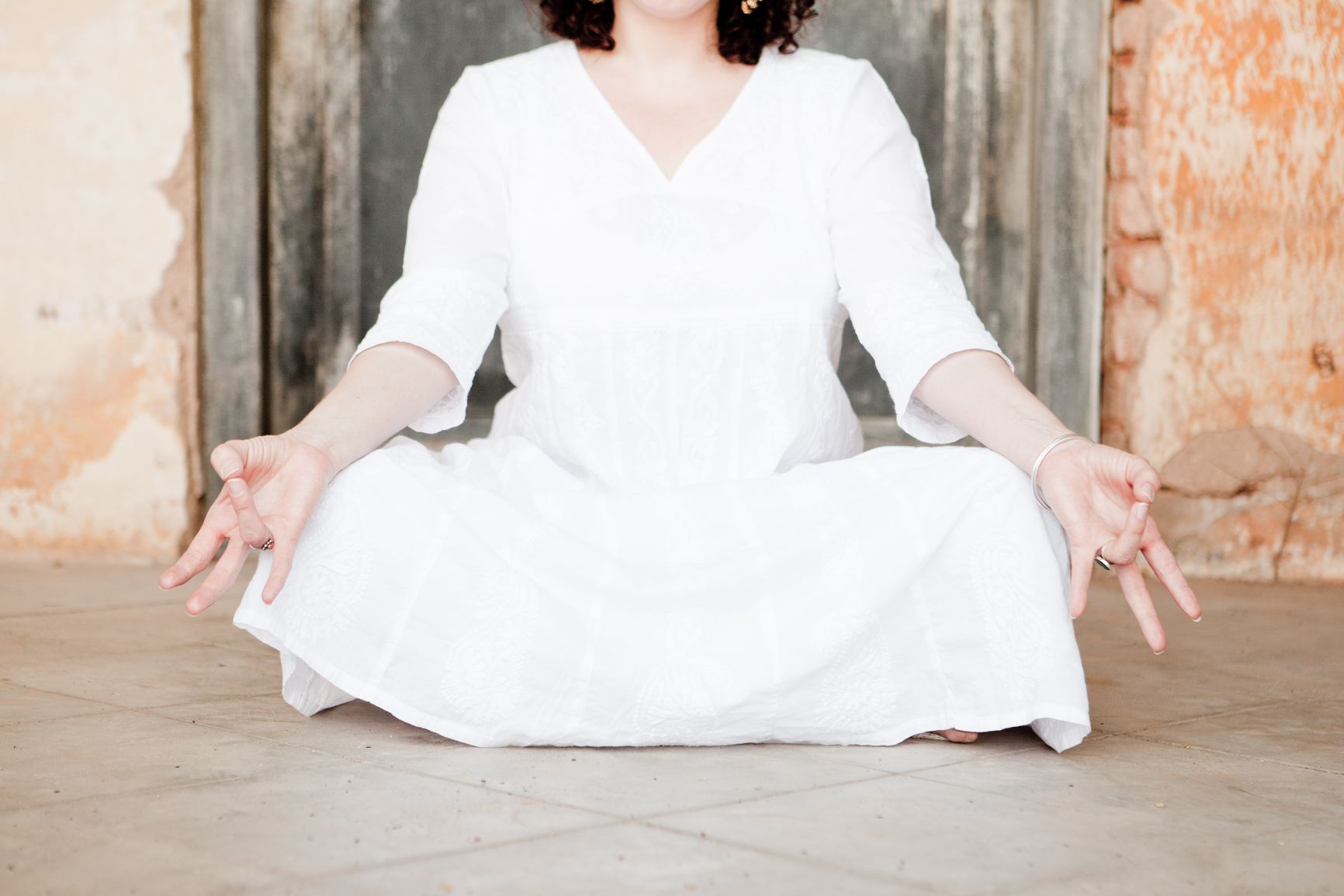With roots that trace back thousands of years, kundalini yoga offers modern benefits, from easing insomnia to reducing anxiety. Here’s what beginners should know about this practice.
In 2010, Rachel Surinderjot Zelaya found herself stuck in a floundering marriage. “We had tried everything including therapy, but we were still codependent, dysfunctional, [and] unhappy,” she recalls. To cope, Zelaya started attending a local kundalini yoga class. “Almost immediately, I noticed a shift in my attitude. In classes, I could feel my energy rising. I realized how much staying in the marriage was shutting me down and depleting me. Kundalini gave me clarity [to acknowledge]: I’m done trying to make this work,” she says. The insight gave her the strength to at last initiate a “peaceful and natural” divorce. “My whole life completely changed from the practice,” she told DailyOM. Today she is a psychotherapist and kundalini teacher in Longmont, Colorado.
Kundalini, or the “Yoga of Awareness”
Stories of emotional epiphanies are common for practitioners of kundalini yoga. Indeed, kundalini’s nickname is the “yoga of awareness,” nodding to its spiritual focus.
Kundalini derives from the Sanskrit word kundal, or “coiled energy.” “Kundalini energy has been conceptualized as a snake at the base of the spine coiled around itself three and a half times,” Erin Elizabeth Downing, author of Kundalini Yoga Demystified: A Modern Guide to What It Is and How to Practice, tells DailyOM. Kundalini yoga combines various practices such as meditative exercises, physical activities, chanting, and breathing techniques to help free up stuck energy and enhance energy levels. “Your kundalini energy can be thought of as awakening your most authentic self, your power, your intuition,” says Downing.
In our stressed-out pandemic times, kundalini is having a moment: Celebrities from Oprah to Reese Witherspoon are reportedly devotees. You can find classes at yoga centers and, increasingly, on YouTube, digital platforms, and even apps. But kundalini’s history is rooted in thousands of years of tradition. While its precise origin is murky, kundalini is referenced in the Upanishads, the sacred scriptures of Hinduism that date back to the fifth century B.C. Kundalini’s current incarnation was first brought to the United States by Yogi Bhajan in 1969.
Your kundalini energy can be thought of as awakening your most authentic self, your power, your intuition.
Interested in learning more? Check out 5-Week Kundalini Yoga for Chakras
What Are the Health Benefits of Kundalini Yoga?
While kundalini’s approach may sound mystical, a small but growing body of scientific research is detecting measurable benefits from the practice. Those include:
Stress Reduction
Research conducted in 2017 revealed that kundalini yoga had an instantaneous effect of decreasing cortisol, the hormone responsible for stress. With frequent practice, kundalini also diminished the participants' sense of stress. One reason for such effects may be the emotional release that people can experience, says Zelaya. “You might start crying in the middle of a movement and think, I didn’t even know I had those tears. There’s a clearing of energy out of the body.”
Improved Sleep
For people who struggle with falling or staying asleep, kundalini yoga may be a possible solution to your disrupted nighttime zzzs. A 2021 study reported that practicing kunalini yoga eased insomnia better than being coached in standard sleep hygiene practices. Even better? When researchers followed up with participants six months later, they continued to show better sleep success than their non-kundalini practicing study counterparts.
Anxiety Relief
Another 2021 study found kundalini yoga was an effective treatment for Generalized Anxiety Disorder (GAD), though researchers, it is important to note, say findings support Cognitive Behavioral Therapy (CBT) as more effective. That said, kundalini yoga may be a helpful addition to your mental health toolbox, along with therapy and other strategies for diminishing stress and anxiety.
What to Expect From a Kundalini Yoga Class
A typical kundalini class has a different vibe from other forms of yoga. While each kundalini teacher has their own unique approach, classes are often organized around a particular intention, such as boosting intuition or improving digestion, says Downing. Instructors choose from numerous kriyas offered by Kundalini yogic practice, which are composed of meditation, physical posture, affirmations, and breathing techniques to help reach intended objectives. Generally, a lesson begins with singing a mantra or sacred utterance
Classes often begin with chanting a mantra, or sacred sound. “Saying a mantra is like tuning in to the energy of all the teachers that have come before, all the wisdom. I tell students it’s like getting on the Wi-Fi signal for your practice,” Abigail Hunter Julia, a kundalini teacher and coach in Austin, Texas, explains to DailyOM.
With eyes closed and palms together, students might chant the adi mantra three times to get centered, for instance. Then the teacher may lead students through a series of movements such as sufi grinds, where you sit crossed-legged and circle your torso above your hips while inhaling and exhaling deeply, or the butterfly, where you sit with feet together, moving your knees up and down so your legs look like the wings of a butterfly flapping. You may repeat the same movement over and over for several minutes. (Repetition is believed to get energy flowing.) A class may also include breathwork exercises such as alternate nostril breathing, where you block one nostril at a time as you inhale and exhale.
Another characteristic: Teachers and students often wear white turbans, though doing so is strictly optional. “White can be a symbol of clarity and uplift,” says Zelaya. Also, “unlike other forms of yoga, we practice with [our] eyes closed,” she adds. “We don’t have mirrors in the studio. It’s not about what it looks like on the outside. It is what it feels like on the inside.”
What’s a Kundalini “Awakening”?
These practices are meant to work together to balance and unblock chakras — the body’s seven energy centers. “During a kundalini awakening, your energy activates and it moves up the spine. People describe it as euphoric,” says Julia. “It can feel like suddenly you have 1,000 rooms in your body you didn’t know you had and all the lights are turned on.”
For some, these powerful experiences can be disturbing. (Google “kundalini” and you will see lots of references to the “danger” of kundalini awakenings.) “If you have experienced trauma in the past, a lot of stuff can come up. So much change can come with this practice. You want to go slow and get support to process it if you start to feel overwhelmed at any time,” says Julia.
But in general, kundalini yoga is considered safe for all abilities, says Downing. “A lot of kundalini’s practices are done sitting or lying down.” Do check with your doctor if you are pregnant or have health concerns like a bad back, advise our experts.
While a typical class may last for an hour or more, you can benefit from a short practice, too. “Consistency is powerful,” says Downing. “Even three minutes every day can give you benefits. That is the magic of it.” Concludes Julia: “The real changes happen off the mat. You can find yourself less reactive, more open to opportunities as you let go of what was keeping you stuck.”

